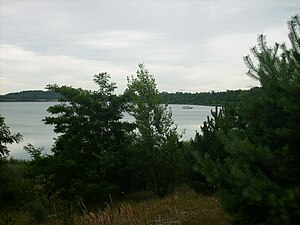Runstedter See
| Runstedter See | ||
|---|---|---|

|
||
| Runstedter See from the west | ||
| Geographical location | Saxony-Anhalt | |
| Islands | no | |
| Data | ||
| Coordinates | 51 ° 18 '4 " N , 11 ° 56' 7" E | |
|
|
||
| Altitude above sea level | 97 m above sea level NN | |
| surface | 230 ha | |
| length | 3.1 km | |
| width | 2.4 km | |
| volume | 55 million cubic meters | |
| scope | 6.1 km | |
| Maximum depth | 32 m | |
|
particularities |
former open-cast lignite mine |
|
The Runstedter See (open pit Großkayna ) is part of the Geiseltaler lake complex.
Geographical location
The Runstedter See lies between Großkayna and Frankleben next to the much larger Geiseltalsee , the Südfeldsee in the south and the much smaller Hassesee near Roßbach . The greatest length of the Runstedter See is 3.1 km, the greatest width 2.4 km and the shore length 6.1 km.
history
The Runstedter See is a former open- cast lignite mine in the Geiseltal district, which was opened from 2001 to 2003 a. a. the Saale was flooded with water. The Runstedter See is expressly not a bathing lake, since between the 1960s and 90s, partly highly toxic power plant ashes and other industrial residues from the Leuna works were discharged into the remaining open pit. For this reason, among other things, deep water aeration has been carried out since the flooding to improve the water quality. In order to guarantee the aerobic microbial degradation of the ammonium loads from the submerged contaminated sites, three deep water aeration systems (TWBA) are in use. The lake is still under mountain supervision . Due to the toxic contamination, the LMBV categorically rules out the use of the lake as bathing water in the future.
The lake got its name from the town of Runstedt , which was first mentioned in 1085 and which had to give way to mining from 1929. The more than 300 residents were relocated to Frankleben.

